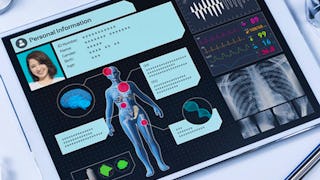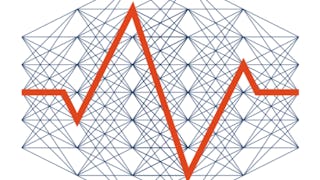Overview of the main principles of Deep Learning along with common architectures. Formulate the problem for time-series classification and apply it to vital signals such as ECG. Applying this methods in Electronic Health Records is challenging due to the missing values and the heterogeneity in EHR, which include both continuous, ordinal and categorical variables. Subsequently, explore imputation techniques and different encoding strategies to address these issues. Apply these approaches to formulate clinical prediction benchmarks derived from information available in MIMIC-III database.



Deep learning in Electronic Health Records - CDSS 2
Ce cours fait partie de Spécialisation Informed Clinical Decision Making using Deep Learning

Instructeur : Fani Deligianni
1 873 déjà inscrits
Inclus avec 
Expérience recommandée
Expérience recommandée
Ce que vous apprendrez
Train deep learning architectures such as Multi-layer perceptron, Convolutional Neural Networks and Recurrent Neural Networks for classification
Validate and compare different machine learning algorithms
Preprocess Electronic Health Records and represent them as time-series data
Imputation strategies and data encodings
Détails à connaître

Ajouter à votre profil LinkedIn
5 devoirs
Découvrez comment les employés des entreprises prestigieuses maîtrisent des compétences recherchées

Élaborez votre expertise du sujet
- Apprenez de nouveaux concepts auprès d'experts du secteur
- Acquérez une compréhension de base d'un sujet ou d'un outil
- Développez des compétences professionnelles avec des projets pratiques
- Obtenez un certificat professionnel partageable


Obtenez un certificat professionnel
Ajoutez cette qualification à votre profil LinkedIn ou à votre CV
Partagez-le sur les réseaux sociaux et dans votre évaluation de performance

Il y a 4 modules dans ce cours
This week includes an overview of deep learning history and popular deep learning platforms. Subsequently, Multi-Layer Perceptron (MLP) Networks are discussed along with common activation functions, loss functions and optimisation algorithms. Finally, the practical exercises will allow to optimise and evaluate MLP in ECG classification.
Inclus
7 vidéos5 lectures1 devoir1 sujet de discussion4 laboratoires non notés
Convolutional Neural Networks (CNNs) revolutionised the way we process images and they contributed significantly in deep learning success. This week we are going to discuss what advantages CNNs offer over MLP and we will implement CNNs for time-series classifications. Subsequently, we are going to present Recurrent Neural Networks (RNNs). In particular, we are going to discuss Long-Short Term Memory Networks and Gated Recurrent Unit Networks. Practical exercises will allow to design and train all these types of networks in ECG classification. The importance of training, validation and testing datasets will be emphasised for avoiding overfitting and model evaluation.
Inclus
3 vidéos6 lectures1 devoir1 sujet de discussion5 laboratoires non notés
Developing benchmark datasets for DNNs based on MIMIC-III database involves several steps that include cohort selection, unit conversion, outlier removal and aggregation of data within time windows. The later step allows to represent EHR as time-series data but it is also susceptible to missing data. For this reason imputation strategies both based on traditional and deep learning techniques are presented. The learner will have the opportunity to preprocess EHR and train deep learning models in predicting in-hospital mortality.
Inclus
4 vidéos8 lectures1 devoir1 sujet de discussion5 laboratoires non notés
EHRs include categorical, ordinal and continuous variables. Appropriate data representation is important and encodings affect prediction performance. This week includes several different strategies to encode the data such as target encodings, deep learning encodings and similarity encodings. In particular, autoencoders which is a deep learning architecture to represent data in lower dimensional space will be demonstrated and applied in in-hospital mortality prediction.
Inclus
4 vidéos5 lectures2 devoirs1 sujet de discussion4 laboratoires non notés
Instructeur

Offert par
En savoir plus sur Machine Learning


University of Glasgow


University of Illinois Urbana-Champaign


University of Illinois Urbana-Champaign


University of Glasgow
Pour quelles raisons les étudiants sur Coursera nous choisissent-ils pour leur carrière ?





Ouvrez de nouvelles portes avec Coursera Plus
Accès illimité à 10,000+ cours de niveau international, projets pratiques et programmes de certification prêts à l'emploi - tous inclus dans votre abonnement.
Faites progresser votre carrière avec un diplôme en ligne
Obtenez un diplôme auprès d’universités de renommée mondiale - 100 % en ligne
Rejoignez plus de 3 400 entreprises mondiales qui ont choisi Coursera pour les affaires
Améliorez les compétences de vos employés pour exceller dans l’économie numérique
Foire Aux Questions
Access to lectures and assignments depends on your type of enrollment. If you take a course in audit mode, you will be able to see most course materials for free. To access graded assignments and to earn a Certificate, you will need to purchase the Certificate experience, during or after your audit. If you don't see the audit option:
The course may not offer an audit option. You can try a Free Trial instead, or apply for Financial Aid.
The course may offer 'Full Course, No Certificate' instead. This option lets you see all course materials, submit required assessments, and get a final grade. This also means that you will not be able to purchase a Certificate experience.
When you enroll in the course, you get access to all of the courses in the Specialization, and you earn a certificate when you complete the work. Your electronic Certificate will be added to your Accomplishments page - from there, you can print your Certificate or add it to your LinkedIn profile. If you only want to read and view the course content, you can audit the course for free.
If you subscribed, you get a 7-day free trial during which you can cancel at no penalty. After that, we don’t give refunds, but you can cancel your subscription at any time. See our full refund policy.
Plus de questions
Aide financière disponible,

